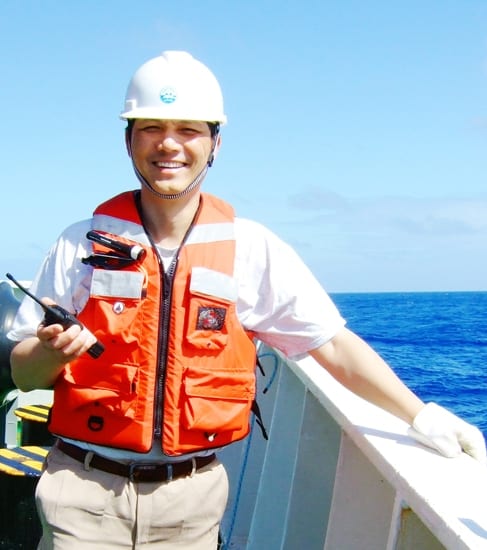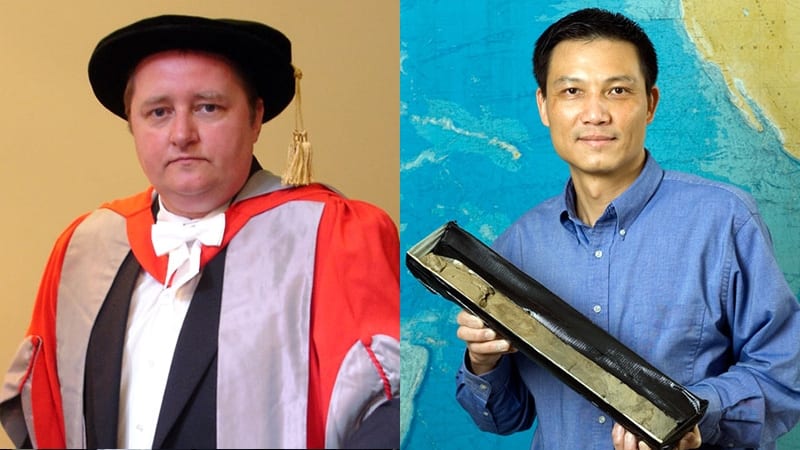News Releases
WHOI Announces 2010 Ocean Science Journalism Fellows
Ten writers and multimedia science journalists from the U.S. and Great Britain have been selected to participate in the competitive Woods Hole Oceanographic Institution (WHOI) Ocean Science Journalism Fellowship program.…
Read MoreChile Quake Occurred in Zone of “Increased Stress”
The massive, 8.8-magnitude earthquake that struck Chile Feb. 27 occurred in an offshore zone that was under increased stress caused by a 1960 quake of magnitude 9.5, according to geologist Jian Lin of the Woods Hole Oceanographic Institution (WHOI).
Read MoreWHOI Expert: Haiti quake occurred in complex, active seismic region
The magnitude 7.0 earthquake that triggered disastrous destruction and mounting death tolls in Haiti this week occurred in a highly complex tangle of tectonic faults near the intersection of the Caribbean and North American crustal plates, according to a quake expert at the Woods Hole Oceanographic Institution (WHOI) who has studied faults in the region and throughout the world.
Read MoreNew Tsunami Education Web Site Developed by Oceanographers
Scientists and Web developers at the Woods Hole Oceanographic Institution (WHOI) have created a new educational Web site with crucial tips on how to prepare for and survive a tsunami.…
Read MoreHybrid Remotely Operated Vehicle Nereus Reaches Deepest Part of the Ocean
A new type of deep-sea robotic vehicle called Nereus has successfully reached the deepest part of the world’s ocean, reports a team of U.S. engineers and scientists aboard the research…
Read MoreJian Lin Named a Fellow of the American Association for the Advancement of Science
Jian Lin of the Woods Hole Oceanographic Institution (WHOI) has been named a fellow of the American Association for the Advancement of Science (AAAS). Election as a fellow is an…
Read MoreMay 2008 Earthquake in China Could Be Followed by Another Significant Rupture
Researchers analyzing the May 2008 Wenchuan earthquake in China?s Sichuan province have found that geological stress has significantly increased on three major fault systems in the region. The magnitude 7.9 quake on May 12 has brought several nearby faults closer to failure and could trigger another major earthquake in the region.
Read MoreWHOI VP for Marine Operations Bob Detrick Appointed to NSF Post
The National Science Foundation (NSF) Directorate for Geosciences has appointed Robert Detrick of the Woods Hole Oceanographic Institution (WHOI) as its new director of the Division of Earth Sciences. Detrick…
Read MoreEarth’s Moving Crust May Occasionally Stop
The motion, formation, and recycling of Earth?s crust?commonly known as the theory of plate tectonics?have long been thought to be continuous processes. But new research by geophysicists suggests that plate tectonic motions have occasionally stopped in Earth?s geologic history, and may do so again.
Read MoreWHOI Geologists Recognized for Achievements
Two senior scientists in the Department of Geology and Geophysics at the Woods Hole Oceanographic Institution (WHOI) have been honored for their outstanding contributions to understanding the makeup and dynamics…
Read MoreLessons from the 2004 Indian Ocean Tsunami Topic of Public Forum
How coastal communities manage risks associated with major tsunamis is an issue of global importance following the devastating 2004 Indian Ocean tsunami that killed an estimated 200,000 people and caused…
Read MoreNew Instrumentation May Help Scientists Understand Earthquake Mechanics
Hundreds of earthquakes occur every day around the world, most of them underneath the oceans, while the vast majority of instruments used to record earthquakes are on land. As a…
Read MoreWHOI Blog from AGU
Check the WHOI blog for news updates from the American Geophysical Union (AGU) fall meeting. More than 10,000 Earth, space and ocean scientists are converging on San Francisco this week…
Read MorePhoning Home from the Ocean Floor – by Computer
Oceanographers will soon be able to sit in their labs ashore and communicate with instruments in the water at ocean observatories around the world, enabling researchers to direct instruments to…
Read MoreA New Seafloor Observatory System
Monitoring earthquakes and changing ocean conditions, and adapting experiments to those changes, will now be possible with a new type of acoustically-linked moored observatory developed by WHOI scientists and engineers…
Read MoreOceanus Magazine Available Online
Oceanus, the oceanography magazine produced by WHOI, now has an online version at https://www.whoi.edu/oceanus/. Initial articles feature deep ocean exploration, such as the evolutionary puzzle of seafloor life, life beneath…
Read MoreNew Hybrid Vehicle Will Enable U.S. Scientists to Reach Deepest Parts of the World Ocean Floor
For the first time since 1960, US scientists will be able to explore the deepest parts of the world’s oceans, up to seven miles below the surface, with a novel underwater vehicle capable of performing multiple tasks in extreme conditions. Researchers at the Woods Hole Oceanographic Institution (WHOI) are developing a battery-powered underwater robot to enable scientists to explore the ocean’s most remote regions up to 11,000 meters (36,000-feet) deep.
Read MoreScientists Report New Type of Mid-Ocean Ridge in Remote Parts of the Earth
Scientists from the Woods Hole Oceanographic Institution (WHOI) have identified a new type of ocean ridge that is spreading so slowly that Earth’s mantle is exposed over large regions of the sea floor. Their findings of a new ultraslow class of ridge, reported in the November 27 issue of the journal Nature, offer a major change in thinking about the formation of the great crustal plates that make up the surface of the earth.
Read MoreScientists Find Active Underwater Volcano East of Samoa
Marine geologists from the Woods Hole Oceanographic Institution (WHOI) and the Scripps Institution of Oceanography (SIO) have confirmed the existence of an active underwater volcano east of Samoa. The volcano, recently named VailuluA?u by local students, is located about 28 miles east of TaA?u Island and rises more than 16,400 feet from the seafloor to within 2,000 feet of the ocean surface. The scientists found billowing “smoggy” water in the summit and extending out for more than five miles.
Read MoreUndersea Cracks along Continental Shelf Could Trigger Tsunamis along U.S. East Coast
Potential landslides on the outer continental shelf and slope along the Mid-Atlantic coast could trigger tsunamis that might have devastating effects on populated coastal areas. In a paper published in the May 2000 issue of the journal Geology,Neal Driscoll of the Woods Hole Oceanographic Institution and colleagues Jeffrey Weissel of Columbia University??A?s Lamont-Doherty Earth Observatory and John Goff of the University of Texas at Austin say newly discovered cracks along the edge of the continental shelf could be an early warning sign that the seafloor is unstable in these areas.
Oceanographer Takes Cable Industry on Journey into the World’s Oceans
(Washington, DC) Robert B. Gagosian, Director of the Woods Hole Oceanographic Institution (WHOI), told the Washington Metropolitan Cable Club today that new technologies are completely changing the way oceanographers do ocean science, and that many problems facing society today can be solved if policymakers and others use this knowledge and technology wisely.
Read MoreActive 14,000 Foot Submarine Volcano Found near Samoa in South Pacific
An active volcano rising more than 4,300 meters (over 14,100 feet) from the ocean floor in the Samoa Islands has been discovered by a team of U.S. scientists, providing more evidence to the scientific debate over the formation of hot spot island chains. The volcano, more than 35 kilometers (about 22 miles) across at its base, rises to within 600 meters (about 2,000 feet) of the surface; its peak is marked by a circular caldera some two kilometers (over 1 mile) across and 400 meters (1,300 feet) deep. It is similar in size to Mt. Whitney in California, the largest mountain in the contiguous 48 U.S. states.
Read MoreMarie Tharp Honored at Women Pioneers Seminar
Oceanographic cartographer Marie Tharp, co-creator of the first world ocean floor map and co-discoverer of the central rift valley that runs through the Mid-Atlantic Ridge, was honored by the Women’s Committee of the Woods Hole Oceanographic Institution (WHOI) March 30 with the 1999 Women Pioneers in Oceanography Award.
Read MoreScientists Plug Into Power and Communications ‘Outlet’ on the Seafloor
Scientists and engineers from the Woods Hole Oceanographic Institution (WHOI) and colleagues have successfully created the first permanent deep ocean seafloor observatory in the United States by connecting a junction…
Read More

